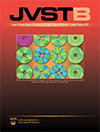
JOURNAL OF VACUUM SCIENCE & TECHNOLOGY B
Scope & Guideline
Exploring Innovations in Condensed Matter and Engineering
Introduction
Aims and Scopes
- Vacuum Technology and Applications:
The journal covers a wide range of applications of vacuum technology, including its use in semiconductor fabrication, materials processing, and the development of devices such as photodetectors and field emitters. - Materials Science and Engineering:
Research on advanced materials, particularly those synthesized or modified in vacuum environments, is a core focus. This includes studies on thin films, nanostructures, and their properties. - Characterization Techniques:
The journal publishes studies that utilize various characterization techniques (e.g., SEM, XPS, SIMS) to investigate the properties and behaviors of materials under vacuum conditions. - Plasma Processing:
Research involving plasma technologies, particularly in the context of etching, deposition, and surface modification, is a significant area of interest, highlighting innovations in plasma-assisted techniques. - Device Fabrication and Performance:
The journal emphasizes research on the fabrication of novel electronic and optoelectronic devices, focusing on the integration of new materials and technologies to enhance performance.
Trending and Emerging
- Advanced Nanostructured Materials:
There is a notable increase in research on nanostructured materials, particularly those fabricated or modified under vacuum conditions, which are being explored for their unique properties and applications in electronics and photonics. - Integration of Machine Learning in Fabrication:
Emerging studies are investigating the application of machine learning algorithms to optimize fabrication processes and improve the predictability of outcomes in nanofabrication. - Sustainable and Green Technologies:
Research focused on sustainable practices within vacuum technology and materials processing is gaining traction, reflecting a broader trend towards environmentally friendly manufacturing methods. - Quantum and Novel Device Architectures:
There is an increasing interest in the development of quantum devices and novel electronic architectures that utilize vacuum technology, indicating a convergence of vacuum science with quantum computing and advanced electronics. - Plasma-Based Innovations:
Research on innovative plasma applications, particularly in the context of etching and deposition processes for next-generation materials and devices, is trending, showcasing advancements in plasma technology.
Declining or Waning
- Conventional Semiconductor Processes:
Research focusing solely on traditional semiconductor fabrication processes is becoming less frequent, as there is a growing emphasis on novel materials and advanced techniques that enhance device performance. - Basic Vacuum Measurements:
Studies that primarily deal with basic vacuum measurement techniques are declining, as the journal shifts towards more complex interactions and applications of vacuum technology in novel systems. - Classical Electrode Materials:
Papers centered on conventional electrode materials are waning, giving way to research on innovative materials that offer improved electrical properties or performance in emerging applications.
Similar Journals

PHYSICS OF THE SOLID STATE
Connecting Academia and Industry through Rigorous ResearchPhysics of the Solid State is a distinguished journal published by Pleiades Publishing Inc., focusing on the rapid advancements and fundamental research in the realms of condensed matter physics, electronic, optical, and magnetic materials. With an ISSN of 1063-7834 and an E-ISSN of 1090-6460, this journal serves as a crucial platform for disseminating high-quality research findings, insights, and reviews essential for both academic and industrial professionals in the field. As of 2023, its Scopus ranking places it in the 26th percentile for both Condensed Matter Physics and Electronic, Optical and Magnetic Materials, reflecting its evolving influence and contribution to the scientific community. Although currently classified in the Q4 quartile, the journal aims to foster interdisciplinary dialogue, improve research visibility, and enhance its impact on contemporary scientific challenges through rigorous peer-reviewed articles and focused special issues. Despite its traditional model of access, it continues to play a pivotal role in engaging researchers and fostering innovation in solid-state physics.

Superconductivity
Exploring innovative applications in superconductivity.Superconductivity is a prestigious open-access journal published by Elsevier, dedicated to advancing the field of superconductivity and its applications across various domains. Launched in 2022, this journal has quickly established itself as a pivotal platform for researchers and professionals, earning a distinguished Q1 ranking in multiple categories including Condensed Matter Physics, Electrical and Electronic Engineering, Electronic, Optical and Magnetic Materials, and Energy Engineering and Power Technology. Researchers can access the journal freely, promoting broad dissemination of innovative research findings to a global audience. With a significant focus on multidisciplinary approaches, the journal encourages submissions that explore the theoretical, experimental, and practical aspects of superconductivity. Given its high visibility and the rigorous peer-review process, Superconductivity is an essential resource for those aiming to contribute to the cutting-edge advancements in this transformative field.

MATERIALS SCIENCE-POLAND
Fostering Collaboration in the World of MaterialsMATERIALS SCIENCE-POLAND, published by SCIENDO, is an esteemed open access journal dedicated to the rapidly evolving field of materials science. Since its inception in 2002 and transitioning to an open access model in 2015, the journal has been a vital platform for researchers and professionals to disseminate their findings and contribute to the scientific community. With an ISSN of 2083-134X and an E-ISSN of 2083-134X, it spans a comprehensive range of disciplines, focusing on condensed matter physics, materials science, and mechanical engineering among others. In the 2023 rankings, it holds a position in the Q4 and Q3 quartiles across various categories, showcasing its relevance and ongoing contribution to these fields. Researchers benefit from its accessibility, enabling wider reach and engagement with contemporary topics in material innovation and applications. As the journal continues to evolve until 2024, it remains a cornerstone for scholars looking to advance their knowledge and research in materials science.
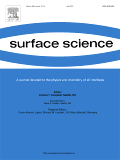
SURFACE SCIENCE
Exploring the Frontiers of Surface PhenomenaSURFACE SCIENCE is a prominent journal in the fields of Condensed Matter Physics, Materials Chemistry, and Surface Engineering, published by Elsevier in the Netherlands. With an ISSN of 0039-6028 and an E-ISSN of 1879-2758, the journal encompasses a wide range of research related to the physical and chemical properties of surfaces and interfaces, serving as a valuable resource for researchers, professionals, and students alike. As of 2023, it holds a Q3 ranking across multiple categories, indicating its significant contribution to its respective fields, despite room for improvement in its overall impact within the scientific community. Researchers will find that SURFACE SCIENCE provides a platform for innovative and interdisciplinary studies, making it essential for those looking to stay updated on emerging trends and technologies in surface science. While the journal is currently not open access, its reputation and robust indexing reinforce its importance in advancing scientific knowledge and fostering new discoveries.

INDIAN JOURNAL OF PHYSICS
Bridging Theoretical Insights and Experimental DiscoveriesINDIAN JOURNAL OF PHYSICS, published by the Indian Association for Cultivation of Science, serves as a pivotal platform for researchers and scholars in the field of physics and astronomy. With its ISSN 0973-1458 and E-ISSN 0974-9845, this journal is committed to presenting innovative research and developments across diverse topics in physics, covering both theoretical and experimental studies. The journal has made its mark in the academic community, evidenced by its classification in the Q3 category within the Physics and Astronomy domain as of 2023, and ranks #100 out of 243 in the Scopus curated database, placing it in the 59th percentile. Spanning from 2005 to 2024, the INDIAN JOURNAL OF PHYSICS aims to foster knowledge exchange and stimulate discussions among physicists and scientific enthusiasts. Whether you are a researcher looking to publish your findings, a professional seeking updates in your field, or a student eager to explore varying aspects of physics, this journal is an invaluable resource contributing significantly to the understanding and advancement of physics in India and beyond.

Materials Letters-X
Unlocking Innovations in Mechanics and MaterialsMaterials Letters-X, published by ELSEVIER, is an esteemed open-access journal dedicated to the rapid communication of research in the fields of Condensed Matter Physics, Materials Science, Mechanical Engineering, and Mechanics of Materials. Launched in 2019, this journal has quickly established itself within the academic community, achieving Q3 quartile rankings in several categories according to the 2023 metrics. The journal's impactful contributions are reflected in its Scopus rankings, notably within Mechanical Engineering (Rank #308) and Mechanics of Materials (Rank #199). The open-access model promotes widespread dissemination and accessibility, ensuring that cutting-edge advancements in material science are readily available to researchers, professionals, and students worldwide. As it continues to grow, Materials Letters-X aims to inspire innovation and collaboration across disciplines, making it a pivotal resource for those engaged in material research and applications.
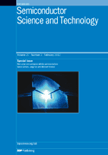
SEMICONDUCTOR SCIENCE AND TECHNOLOGY
Driving collaboration in semiconductor science and technology.Semiconductor Science and Technology is a pivotal journal in the fields of condensed matter physics, electrical and electronic engineering, and materials science, published by IOP Publishing Ltd. With an ISSN of 0268-1242 and an E-ISSN of 1361-6641, this esteemed journal has been disseminating groundbreaking research since 1986 and is set to continue through 2024. Recognized in the latest categorizations, it holds a notable Q2 ranking in Condensed Matter Physics, Electrical and Electronic Engineering, and Materials Chemistry, alongside a Q3 ranking in Electronic, Optical, and Magnetic Materials, highlighting its significant contribution to the advancement of these disciplines. Although it does not operate under an open access model, the journal provides critical access options for researchers and professionals seeking to foster innovation and collaboration within the semiconductor community. As a vital resource, Semiconductor Science and Technology not only supports the dissemination of high-quality research but also serves as a platform for emerging trends and developments that are shaping the future of semiconductor technology.
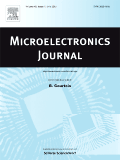
MICROELECTRONICS JOURNAL
Elevating the Standards of Microelectronics Research and DevelopmentMICROELECTRONICS JOURNAL, published by Elsevier Sci Ltd since 1974, serves as a pivotal platform for disseminating cutting-edge research in the realms of microelectronics, nanotechnology, and materials science. With editions spanning from 1974 to 2024, the journal is well-respected within the scientific community, boasting a strong presence in key categories such as Atomic and Molecular Physics, Condensed Matter Physics, and Electrical and Electronic Engineering, as evidenced by its Q3 ranking in 2023. Researchers and professionals engaged in the exploration of electronic materials, optical applications, and nanoscale innovations can greatly benefit from the journal's insights, which situate their work within a robust academic framework. Although the journal does not currently offer open access, its rigorous peer-review process and high visibility in Scopus rankings—including a percentile ranking of 58th in Condensed Matter Physics—make it an essential resource for anyone looking to stay at the forefront of advancements in microelectronics and related fields.
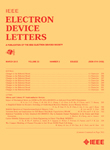
IEEE ELECTRON DEVICE LETTERS
Advancing the Frontiers of Electronic InnovationIEEE Electronics Device Letters, published by the esteemed IEEE-Institute of Electrical and Electronics Engineers Inc, stands at the forefront of innovation in the field of electrical and electronic engineering. With a rich history spanning from 1980 to 2024, this journal showcases groundbreaking research and letters that significantly contribute to the advancement of electronic, optical, and magnetic materials. Its impressive Q1 rankings in both Electrical and Electronic Engineering and Electronic, Optical, and Magnetic Materials underscore its pivotal role in shaping contemporary academic discourse. The journal maintains a strong position in Scopus rankings, positioned within the top 16% for Electrical and Electronic Engineering and the top 18% for Materials Science, making it a vital resource for researchers, professionals, and students alike. With the absence of open access, it maintains an exclusive repository of high-impact research that experts in the field turn to for the latest insights and developments. IEEE Electronics Device Letters is committed to providing a platform for the dissemination of transformative knowledge that fuels innovation and progress in the ever-evolving landscape of electronics.
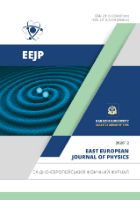
East European Journal of Physics
Fostering collaboration through open-access scholarship.The East European Journal of Physics, published by the V N Karazin Kharkiv National University, is a dynamic open-access journal dedicated to advancing research in the fields of Physics and Materials Science. Since its inception in 2014, the journal has become a platform for scientists and academicians throughout Eastern Europe and beyond, fostering collaboration and dissemination of innovative studies and findings. With its ISSN 2312-4334 and E-ISSN 2312-4539, it attracts a global readership and submissions that are rigorously peer-reviewed to ensure the highest scholarly standards. Despite currently holding a Q4 category ranking in both Materials Science and Physics and Astronomy, as well as modest Scopus rankings, the journal is positioned to play a crucial role in elevating the visibility and impact of research emanating from this geographically and scientifically significant region through an open access model. This commitment to open scholarship is critical for fostering academic exchange and impact, making the East European Journal of Physics a valuable resource for researchers, professionals, and students seeking insight into the latest developments within these fields. Join us in exploring the frontiers of knowledge and innovation from Ukraine and its surrounding areas.